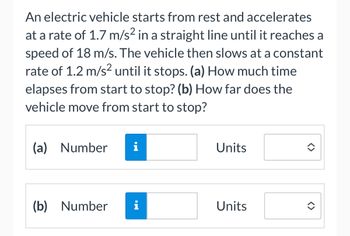
College Physics
11th Edition
ISBN: 9781305952300
Author: Raymond A. Serway, Chris Vuille
Publisher: Cengage Learning
expand_more
expand_more
format_list_bulleted
Concept explainers
Question
thumb_up100%

Transcribed Image Text:An electric vehicle starts from rest and accelerates
at a rate of 1.7 m/s² in a straight line until it reaches a
speed of 18 m/s. The vehicle then slows at a constant
rate of 1.2 m/s² until it stops. (a) How much time
elapses from start to stop? (b) How far does the
vehicle move from start to stop?
(a) Number i
(b) Number
i
Units
Units
<>
Expert Solution
This question has been solved!
Explore an expertly crafted, step-by-step solution for a thorough understanding of key concepts.
This is a popular solution
Trending nowThis is a popular solution!
Step by stepSolved in 3 steps with 3 images

Knowledge Booster
Learn more about
Need a deep-dive on the concept behind this application? Look no further. Learn more about this topic, physics and related others by exploring similar questions and additional content below.Similar questions
- In the given equation, v = At² + Bx, 'v' is the velocity, 'x'is displacement, and 't'is the time. Then the dimensions of A and B are ; B= LT-1 b) A = LT¯1 ; B= T¯1 B = LT-2 ; B = T¯1 a) A = T ; c) A = T-1 d) A = LT-3 O b O aarrow_forwardIf an average-size man jumps from an airplane with an open parachute, his downward velocity t seconds into the fall is v(t) = 20(10.2) feet per second. (a) Use functional notation to express the velocity 3 seconds into the fall. Calculate it. ft per sec (b) Explain how the velocity increases with time. Include in your explanation the average rate of change from the beginning of the fall to the end of the first second and the average rate of " change from the fourth second to the fifth second of the fall. This answer has not been graded yet. (c)-Find the terminal velocity. ft per sec (d) Compare the time it takes to reach 99% of terminal velocity here with the 25 seconds it took a skydiver with his parachute closed to reach 99% of terminal velocity in Example 2.1. On the basis of the information we have, which would you expect to reach 99% of terminal velocity first, O feather feather or a cannonball? O cannonball Need Help? Read Itarrow_forwardA 7760 kg space probe, moving nose-first toward Jupiter at 73.9 m/s relative to the Sun, fires its rocket engine, ejecting 83.0 kg of exhaust at a speed of 248 m/s relative to the space probe. What is the final velocity of the probe? Number Unitsarrow_forward
- 1) A race car travels around a circular race track for which the start line and finish line are at the same location. If the race is 888km long and the radius of the track is 1.414km, how many times did the car go around the track? The race takes 2 hours and 45 minutes, what is the race car’s average velocity (in m/s) over the entire race? What is the race car’s average speed (in m/s) over the entire race?arrow_forward(b) Suppose instead that the true speed of the car as a function of time is described by v(t) = 30√/t (still from t = 0 to t = 4). Sketch a graph of the car's speed vs. time. (c) Since the speed is no longer constant, it is much harder to calculate the distance traveled. But we can still try. Suppose we wanted to calculate how far the car went in the sin minute from 1:00 and 1:01. i. Let's pretend that the car's speed is constant for this single minute. What might be a reasonable approximation for the car's speed, in this scenario? (There is no one single correct answer to this question; make your best estimate.) ii. Under this assumption, approximately how far did the car go during this minute? (Hint: Don't forget that a minute is hours.) 60arrow_forwardProblem 6: Part (a) Determine the amount of time in s it would take to travel 1.25 mm. t1 = ______ Part (b) Determine the amount of time in s it would take to travel 1.1 cm. t2 = ______arrow_forward
arrow_back_ios
arrow_forward_ios
Recommended textbooks for you
 College PhysicsPhysicsISBN:9781305952300Author:Raymond A. Serway, Chris VuillePublisher:Cengage Learning
College PhysicsPhysicsISBN:9781305952300Author:Raymond A. Serway, Chris VuillePublisher:Cengage Learning University Physics (14th Edition)PhysicsISBN:9780133969290Author:Hugh D. Young, Roger A. FreedmanPublisher:PEARSON
University Physics (14th Edition)PhysicsISBN:9780133969290Author:Hugh D. Young, Roger A. FreedmanPublisher:PEARSON Introduction To Quantum MechanicsPhysicsISBN:9781107189638Author:Griffiths, David J., Schroeter, Darrell F.Publisher:Cambridge University Press
Introduction To Quantum MechanicsPhysicsISBN:9781107189638Author:Griffiths, David J., Schroeter, Darrell F.Publisher:Cambridge University Press Physics for Scientists and EngineersPhysicsISBN:9781337553278Author:Raymond A. Serway, John W. JewettPublisher:Cengage Learning
Physics for Scientists and EngineersPhysicsISBN:9781337553278Author:Raymond A. Serway, John W. JewettPublisher:Cengage Learning Lecture- Tutorials for Introductory AstronomyPhysicsISBN:9780321820464Author:Edward E. Prather, Tim P. Slater, Jeff P. Adams, Gina BrissendenPublisher:Addison-Wesley
Lecture- Tutorials for Introductory AstronomyPhysicsISBN:9780321820464Author:Edward E. Prather, Tim P. Slater, Jeff P. Adams, Gina BrissendenPublisher:Addison-Wesley College Physics: A Strategic Approach (4th Editio...PhysicsISBN:9780134609034Author:Randall D. Knight (Professor Emeritus), Brian Jones, Stuart FieldPublisher:PEARSON
College Physics: A Strategic Approach (4th Editio...PhysicsISBN:9780134609034Author:Randall D. Knight (Professor Emeritus), Brian Jones, Stuart FieldPublisher:PEARSON

College Physics
Physics
ISBN:9781305952300
Author:Raymond A. Serway, Chris Vuille
Publisher:Cengage Learning

University Physics (14th Edition)
Physics
ISBN:9780133969290
Author:Hugh D. Young, Roger A. Freedman
Publisher:PEARSON

Introduction To Quantum Mechanics
Physics
ISBN:9781107189638
Author:Griffiths, David J., Schroeter, Darrell F.
Publisher:Cambridge University Press

Physics for Scientists and Engineers
Physics
ISBN:9781337553278
Author:Raymond A. Serway, John W. Jewett
Publisher:Cengage Learning

Lecture- Tutorials for Introductory Astronomy
Physics
ISBN:9780321820464
Author:Edward E. Prather, Tim P. Slater, Jeff P. Adams, Gina Brissenden
Publisher:Addison-Wesley

College Physics: A Strategic Approach (4th Editio...
Physics
ISBN:9780134609034
Author:Randall D. Knight (Professor Emeritus), Brian Jones, Stuart Field
Publisher:PEARSON